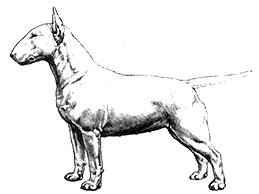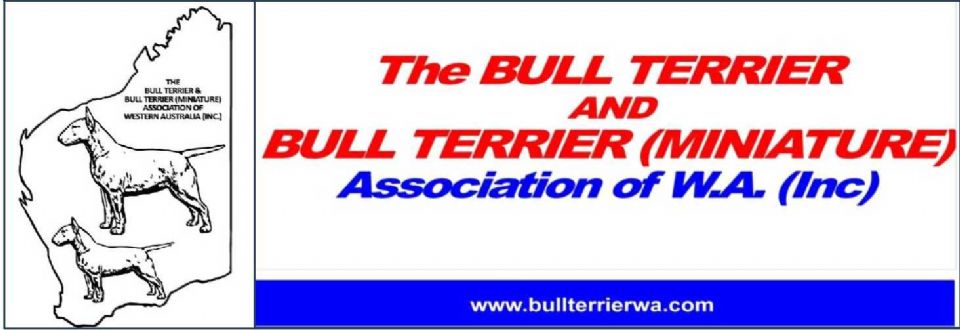BT and BTM Standard
Standards BTM & BT
Extended Breeds Standard - see link below
https://webs.dogs.net.au/bullyminiwa/uploads/documents/Extended-Breed-Standard-BT--and--BTM.pdf
A breed standard is the guideline which describes the ideal characteristics, temperament, and appearance of a breed and ensures that the breed is fit for function with soundness essential. Breeders and judges should at all times be mindful of features which could be detrimental in any way to the health , welfare or soundness of this breed.
.jpg)
-
Group:Group 2 (Terriers)
-
General Appearance:
-
The Standard of the Bull Terrier (Miniature) is the same as that of the Bull Terrier with the exception of the following:
-
Sizes:
Height: should not exceed 35.5 cms (14 ins).
There should be an impression of substance to size of dog. There is no weight limit. Dog shouldat all times be balanced.
-
Bull Terrier Breed StandardLast updated: 05 Aug 2009

Kennel Club, London 1994
FCI Standard No 11a
-
Group:Group 2 (Terriers)
-
History:
-
General Appearance:
Strongly built, muscular, well balanced and active with a keen, determined
and intelligent expression.
-
Characteristics:
Courageous, full of spirit, with a fun loving attitude. A unique feature is a downfaced,
eggshaped head. Irrespective of size dogs should look masculine and bitches feminine.
-
Temperament:
Of even temperament and amenable to discipline. Although obstinate is
particularly good with people.
-
Head And Skull:
Head long, strong and deep right to end of muzzle, but not coarse. Viewed from front
eggshaped and completely filled, its surface free from hollows or indentations.
Top of skull almost flat from ear to ear. Profile curves gently downwards from top of skull
to tip of nose which should be black and bent downwards at tip. Nostrils well developed
and underjaw deep and strong.
-
Eyes:
Appearing narrow and triangular, obliquely placed, black or as dark brown as possible
so as to appear almost black, and with a piercing glint. Distance from tip of nose to
eyes perceptibly greater than from eyes to top of skull. Blue or partly blue undesirable.
-
Ears:
Small, thin and placed closed together. Dog should be able to hold them stiffly erect,
when they point straight upwards.
-
Mouth:
Teeth sound, clean, strong, of good size, regular with a perfect regular and complete
scissor bite, i.e. upper teeth closely overlapping lower teeth and set square to the jaws.
Lips clean and tight.
-
Neck:
Very muscular, long, arched, tapering from shoulders to head and free from loose skin.
-
Forequarters:
Shoulders strong and muscular without loading. Shoulder blades wide, flat and held
closely to chest wall and have a very pronounced backward slope of front edge from
bottom to top, forming almost a right angle with upper arm. Elbows held straight and
strong, pasterns upright. Forelegs have strongest type of round, quality bone, dog
should stand solidly upon them and they should be perfectly parallel. In mature dogs
length of foreleg should be approximately equal to depth of chest.
-
Body:
Body well rounded with marked spring of rib and great depth from withers to brisket,
so that latter nearer ground than belly. Back short, strong with backline behind withers
level, arching or roaching slightly over broad, well muscled loins. Underline from brisket
to belly forms a graceful upward curve. Chest broad when viewed from front.
-
Hindquarters:
Hindlegs in parallel when viewed from behind. Thighs muscular and second thighs
well developed. Stifle joint well bent and hock well angulated with bone to foot short and strong.
-
Feet:
Round and compact with well arched toes.
-
Tail:
Short, set on low and carried horizontally. Thick at root, it tapers to a fine point.
-
Gait/Movement:
When moving appears well knit, smoothly covering ground with free, easy strides and
with a typical jaunty air. When trotting, movement parallel, front and back, only converging
towards centre line at faster speeds, forelegs reaching out well and hindlegs moving smoothly
at hip, flexing well at stifle and hock, with great thrust.
-
Coat:
Short, flat, even and harsh to touch with a fine gloss. Skin fitting dog tightly. A soft textured
undercoat may be present in winter.
-
Colour:
For White, pure white coat. Skin pigmentation and markings on head not be penalised.
For Coloured, colour predominates; all other things being equal, brindle preferred. Black, brindle,
red, fawn and tri-colour acceptable. Tick markings in white coat undesirable.
Blue and liver highly undesirable.
-
Sizes:
There are neither weight nor height limits, but there should be the impression of maximum
substance for size of dog consistent with quality and sex.
-
Faults:
Any departure from the foregoing points should be considered a fault and the seriousness
with which the fault should be regarded should be in exact proportion to its degree and its
effect upon the health and welfare of the dog.
-
Notes:
Male animals should have two apparently normal testicles fully descended into the scrotum.
.
-
Contact Details
BT and BTM Association of WA IncPerth, WA, Australia
Phone : 0408636334
Email : [email protected]
